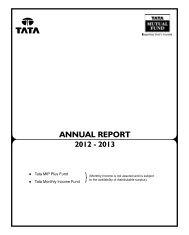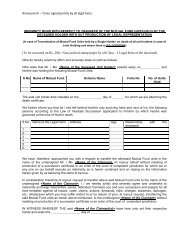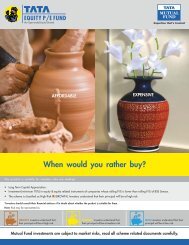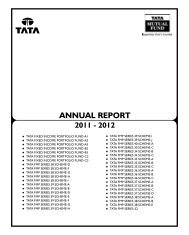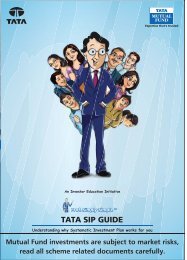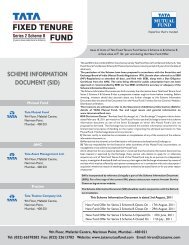Front Cover Page - Tata Mutual Fund
Front Cover Page - Tata Mutual Fund
Front Cover Page - Tata Mutual Fund
Create successful ePaper yourself
Turn your PDF publications into a flip-book with our unique Google optimized e-Paper software.
TATA FLOATER FUND<br />
In view of the fund manager interest rates are expected to move up due to certain negative events which are expected to occur at a specified future<br />
date. In such cases the scheme can enter into a paid position (FRA) at a specified date in the future where the scheme will pay a fixed rate for a<br />
specified maturity and receive the floating rate of interest at a specified future date. This is illustrated below.<br />
Example 1: Use of FRA<br />
The fund Manager believes in 3 months time the interest rates will be higher and decides to enter into an FRA agreement 3x9 to protect the portfolio<br />
return. Say the manager wants to hedge 10% of the portfolio which is for the notional amount of Rs 2 crore where the bank agrees to pay 6% fixed,<br />
in case the 6 month OIS rate is greater than 6% the bank will pay the difference to the portfolio manager 3 months hence for 6 months. Say 3<br />
months hence the OIS rate for six months is 6.50%.<br />
This like IRS is cash settled and the bank at the end of three months will pay the portfolio manager the following (6.50-6.00) x181x<br />
20,000,000/(365*100+6.50*181) = Rs 48,040.55 for six months.<br />
The Plans of the fund are in cash, and the view of the fund manager is interest rates are expected to move down due to certain positive events<br />
which are expected to occur at a specified future date. In such cases the plans can enter into a received position (FRA) at a specified date in the<br />
future where the plans will receive a fixed rate for a specified maturity and pay the floating rate of interest at a specified future date. This is<br />
illustrated below.<br />
Example 2: Use of FRA<br />
The fund Manager believes in 3 months time the interest rates will be lower and decides to enter into an FRA agreement 3x9 to protect the portfolio<br />
return. Say the manager wants to hedge 10% of the portfolio which is for the notional amount of Rs 2 crore where the bank agrees to pay 6% fixed,<br />
in case the 6 month OIS rate is less than 6% the bank will pay the difference to the portfolio manager 3 months hence for 6 months. Say 3 months<br />
hence the OIS rate for six months is 5.50%.<br />
This like IRS is cash settled and the bank at the end of three months will pay the portfolio manager the following (6.00-5.50) x181x 200, 000,<br />
00/(365*100+5.50*181) = Rs 48272.76 for six months.<br />
Interest Rate Future (IRF)<br />
An interest rate future is a financial derivative (a futures contract) with an interest-bearing instrument as the underlying asset. Interest rate futures<br />
are used to hedge against the risk of that interest rates will move in an adverse direction, causing a cost to the company. For example, borrowers<br />
face the risk of interest rates rising. Futures use the inverse relationship between interest rates and bond prices to hedge against the risk of rising<br />
interest rates. A borrower will enter to sell a future today. Then if interest rates rise in the future, the value of the future will fall (as it is linked to the<br />
underlying asset, bond prices), and hence a profit can be made when closing out of the future (i.e. buying the future).<br />
Interest Rate Option (IRO)<br />
Call Options<br />
When someone buys an interest rate call option, they are buying the right to buy the option at a set price. Therefore, if someone buys a call option,<br />
he will profit if interest rates rise.<br />
Call Example<br />
Assume that interest rates are at 5 percent. An investor thinks they will rise in the next 12 months, so he buys a Rs.100 call option for Rs.5. A year<br />
goes by, and interest rates have risen to 10 percent. He can now buy the asset--now worth Rs.110--for Rs.100.<br />
Put Options<br />
Put options are the opposite of call options. These options allow an investor to sell the option at a set price at a set time. This means the investor<br />
will profit from falling interest rates.<br />
Put Example<br />
Assume that interest rates are now at 10 percent. The investor in the above example believes these rates are unsustainably high, so he buys a<br />
Rs.110 put option on his original Rs.100 option. The following year, interest rates fall back to 5 percent, so the Rs.100 only earned Rs.5 in interest.<br />
However, the investor can sell for Rs.110, thus making Rs.5 off an interest rate decline.<br />
Risks associated with Derivatives<br />
Derivative products are leverage instruments and can provide disproportionate gains as well as disproportionate losses to the investors.<br />
Execution of such strategies depends upon the ability of the <strong>Fund</strong> Manager to identify such opportunities. Identification and execution of the<br />
strategies to be pursued by the <strong>Fund</strong> Manager involved uncertainty and decision of <strong>Fund</strong> Manager may not always be profitable. No assurance<br />
can be given that the <strong>Fund</strong> Manager will be able to identify or execute such strategies.<br />
Derivative products are specialized instruments that require investment techniques and risk analysis different from those associated with<br />
stocks and bonds. Derivatives require the maintenance of adequate controls to monitor the transactions entered into, the ability to assess the<br />
risk that a derivative add to the portfolio and the ability to forecast price of securities being hedged and interest rate movements correctly.<br />
There is a possibility that a loss may be sustained by the portfolio as a result of the failure of another party (usually referred to as the<br />
“counterparty”) to comply with the terms of the derivatives contract. Other risks in using derivatives include the risk of mis-pricing or improper<br />
valuation of derivatives and the inability of derivatives to correlate perfectly with underlying assets, rates and indices.<br />
The risks associated with the use of derivatives are different from or possibly greater than, the risks associated with investing directly in<br />
securities and other traditional investments”.<br />
21




